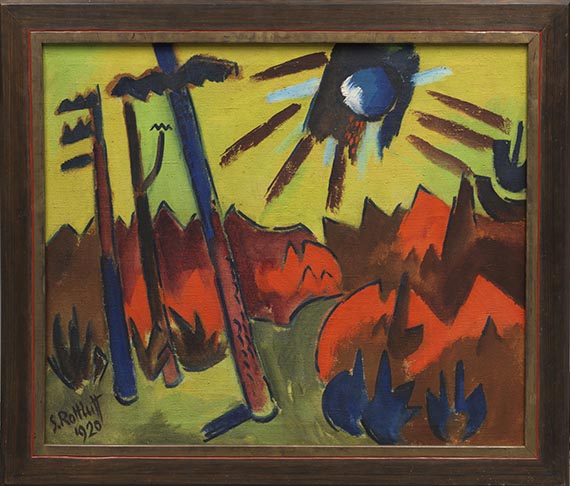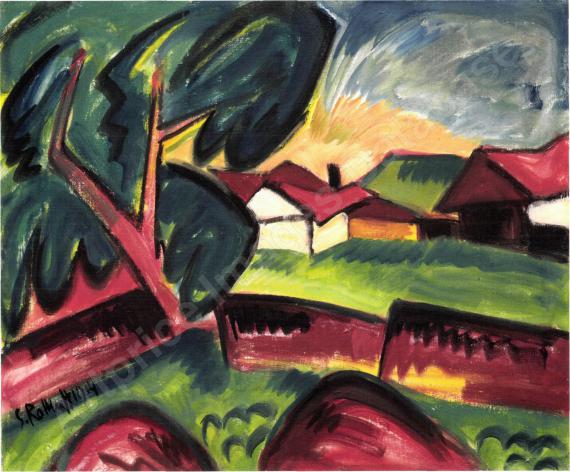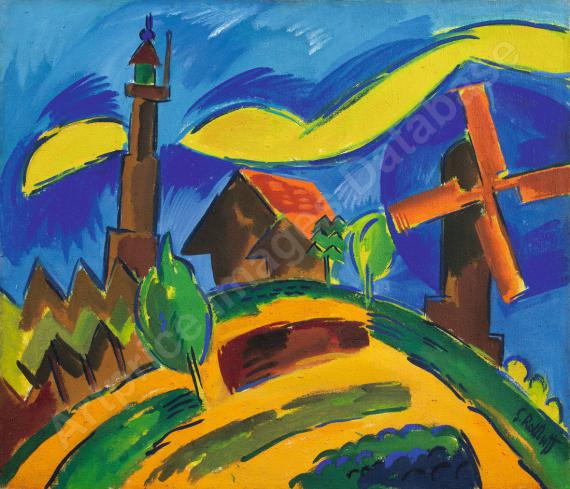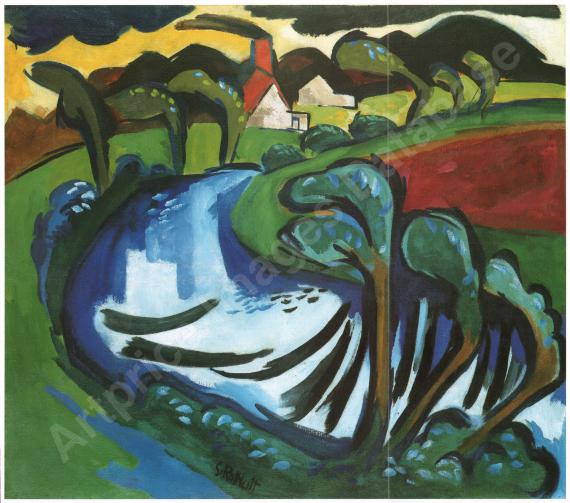Vente: 550 / Evening Sale 07 juin 2024 à Munich  Lot 122000274
Lot 122000274
 Lot 122000274
Lot 122000274
122000274
Karl Schmidt-Rottluff
Junger Wald und Sonne, 1920.
Oil on canvas
Estimation: € 500,000 / $ 535,000
Les informations sur la commission d´achat, les taxes et le droit de suite sont disponibles quatre semaines avant la vente.
Junger Wald und Sonne. 1920.
Oil on canvas.
Signed and dated in lower left. Once more signed, titled "Wald und Sonne" and inscribed with the work number "(2017)" on the reverse of the stretcher. Numbered "91" by a hand other than that of the artist and with the label "Kunstausstellung Alfred Heller / Berlin [illegible] / Kurfürstendamm 44". With the stamp "Alfred Heller / Berlin [illegible]" on the reverse. 76.5 x 90.5 cm (30.1 x 35.6 in).
[KT].
• Expressionist landscape painting at its best: fiery red dunes and a black sun against a bright yellow-green sky.
• The painting was part of a Japanese private collection as early as in 1924, it featured in two highly acclaimed exhibitions in Tokyo under the title "Wakaki Mura" that same year.
• Paintings of this outstanding quality and in such intense color are extremely rare on the auction market.
• A variation of a motif so important in his oeuvre is in the collection of the Museo Thyssen-Bornemisza, Madrid.
The work is documented in the archive of the Karl and Emy Schmidt-Rottluff Foundation, Berlin.
We are grateful to Masayuki Tanaka, Prof. Dr. Toshiharu Omuka and Dr. Shogo Otani for their kind expert advice.
PROVENANCE: Dr. Matheus, Berlin (presumably Dr. Kurt Matheus or his father Dr. Salo Matheus, according to a handwritten note by Rosa Schapire).
Art dealer Alfred Heller, Berlin (presumably 1922).
Private collection Japan (probably Hisataka Munakata (1889-1970) since 1924 the latest, presumably acquired from the above).
Galerie Thomas, Munich.
Hermann Gerlinger Collection, Würzburg (acquired from the above, with the collector's stamp Lugt 6032).
EXHIBITION:
Art dealer Alfred Heller, Berlin (1922?).
Oshu hyogenha bijutsuten [Exhibition of European Expressionism], Maruzen, Tokyo, June 21 – 30, 1924, no. 28 (title: "Wakaki Mura").
Hokuo shinko bijutsuten [Exhibition of Northern European Modern Art], Garo Kudan, Tokyo, December 1 – 15, 1924 (titlt: "Wakaki Mura"), Nr. 88.
Karl Schmidt-Rottluff zum 100. Geburtstag, Schleswig-Holsteinisches Landesmuseum, Schloss Gottorf, June 3 - August 12, 1984, cat. no. 43.
Karl Schmidt-Rottluff, Retrospektive, Kunsthalle Bremen, June 16 - September 10, 1989; Städtische Galerie im Lenbachhaus, Munich, September 27 - December 3, 1989, cat. no. 221 (with black-and-white illu., color plate 78).
Schleswig-Holsteinisches Landesmuseum, Schloss Gottorf, Schleswig (permanent loan from the Collection Hermann Gerlinger, 1995-2001).
Kunstmuseum Moritzburg, Halle an der Saale (permanent loan from the Collection Hermann Gerlinger, 2001-2017).
Expressiv! Die Künstler der Brücke. Die Sammlung Hermann Gerlinger, Albertina Vienna, June 1 - August 26, 2007, cat. no. 59 (illu.).
Karl Schmidt-Rottluffs Landschaften und Stillleben, Saarlandmuseum, Saarbrücken, November 6, 2010 - January 23, 2011, cat. no. 18. (illu.).
Zwei Männer - ein Meer. Pechstein und Schmidt-Rottluff an der Ostsee, Pommersches Landesmuseum, Greifswald, March 29 - August 28, 2015, cat. no. 8 (illu.)
Buchheim Museum, Bernried (permanent loan from the Collection Hermann Gerlinger, 2017-2022).
Brückenschlag: Gerlinger – Buchheim!, Buchheim Museum, Bernried, October 28, 2017 - February 25, 2018, pp. 352f. (illu.).
Schmidt-Rottluff. Form, Farbe, Ausdruck!, Buchheim Museum, Bernried, September 29, 2018 - February 3, 2019, pp. 242f. (illu.).
LITERATURE: Will Grohmann, Karl Schmidt-Rottluff, Stuttgart 1956, p. 264 (with illu.), 291 (here titled: "Sonne mit Wald", private ownership Japan).
- -
Oshu hyogenha bijutsuten (Exhibition of European Expressionism), Maruzen Galerie, in: The Tokyo Asahi Shimbun, June 26, 1924 (illu.).
Sotheby’s, London, Impressionist and Modern Paintings […], April 2, 1981, lot 354 (illu.).
Gerhard Wietek, Karl Schmidt-Rottluff in Hamburg und Schleswig-Holstein, Neumünster 1984, p. 219 (illu. in black and white).
Heinz Spielmann (ed.), Die Maler der Brücke. Collection Hermann Gerlinger, Stuttgart 1995, p. 393, SHG no. 682 (illu.).
Hermann Gerlinger, Katja Schneider (eds.), Die Maler der Brücke. Inventory catalog Collection Hermann Gerlinger, Halle (Saale) 2005, p. 93, SHG no. 196 (illu.).
Toshiharu Omuka, Resonance of Boiling Self and Shared Enthusiasm: Japanese Artists and Collectors in Early 1920s Berlin, in: A Blue Brick. Festschrift in Honor of John E. Bowlt, Frankfurt a. Main 2023, pp. 496-515.
Oil on canvas.
Signed and dated in lower left. Once more signed, titled "Wald und Sonne" and inscribed with the work number "(2017)" on the reverse of the stretcher. Numbered "91" by a hand other than that of the artist and with the label "Kunstausstellung Alfred Heller / Berlin [illegible] / Kurfürstendamm 44". With the stamp "Alfred Heller / Berlin [illegible]" on the reverse. 76.5 x 90.5 cm (30.1 x 35.6 in).
[KT].
• Expressionist landscape painting at its best: fiery red dunes and a black sun against a bright yellow-green sky.
• The painting was part of a Japanese private collection as early as in 1924, it featured in two highly acclaimed exhibitions in Tokyo under the title "Wakaki Mura" that same year.
• Paintings of this outstanding quality and in such intense color are extremely rare on the auction market.
• A variation of a motif so important in his oeuvre is in the collection of the Museo Thyssen-Bornemisza, Madrid.
The work is documented in the archive of the Karl and Emy Schmidt-Rottluff Foundation, Berlin.
We are grateful to Masayuki Tanaka, Prof. Dr. Toshiharu Omuka and Dr. Shogo Otani for their kind expert advice.
PROVENANCE: Dr. Matheus, Berlin (presumably Dr. Kurt Matheus or his father Dr. Salo Matheus, according to a handwritten note by Rosa Schapire).
Art dealer Alfred Heller, Berlin (presumably 1922).
Private collection Japan (probably Hisataka Munakata (1889-1970) since 1924 the latest, presumably acquired from the above).
Galerie Thomas, Munich.
Hermann Gerlinger Collection, Würzburg (acquired from the above, with the collector's stamp Lugt 6032).
EXHIBITION:
Art dealer Alfred Heller, Berlin (1922?).
Oshu hyogenha bijutsuten [Exhibition of European Expressionism], Maruzen, Tokyo, June 21 – 30, 1924, no. 28 (title: "Wakaki Mura").
Hokuo shinko bijutsuten [Exhibition of Northern European Modern Art], Garo Kudan, Tokyo, December 1 – 15, 1924 (titlt: "Wakaki Mura"), Nr. 88.
Karl Schmidt-Rottluff zum 100. Geburtstag, Schleswig-Holsteinisches Landesmuseum, Schloss Gottorf, June 3 - August 12, 1984, cat. no. 43.
Karl Schmidt-Rottluff, Retrospektive, Kunsthalle Bremen, June 16 - September 10, 1989; Städtische Galerie im Lenbachhaus, Munich, September 27 - December 3, 1989, cat. no. 221 (with black-and-white illu., color plate 78).
Schleswig-Holsteinisches Landesmuseum, Schloss Gottorf, Schleswig (permanent loan from the Collection Hermann Gerlinger, 1995-2001).
Kunstmuseum Moritzburg, Halle an der Saale (permanent loan from the Collection Hermann Gerlinger, 2001-2017).
Expressiv! Die Künstler der Brücke. Die Sammlung Hermann Gerlinger, Albertina Vienna, June 1 - August 26, 2007, cat. no. 59 (illu.).
Karl Schmidt-Rottluffs Landschaften und Stillleben, Saarlandmuseum, Saarbrücken, November 6, 2010 - January 23, 2011, cat. no. 18. (illu.).
Zwei Männer - ein Meer. Pechstein und Schmidt-Rottluff an der Ostsee, Pommersches Landesmuseum, Greifswald, March 29 - August 28, 2015, cat. no. 8 (illu.)
Buchheim Museum, Bernried (permanent loan from the Collection Hermann Gerlinger, 2017-2022).
Brückenschlag: Gerlinger – Buchheim!, Buchheim Museum, Bernried, October 28, 2017 - February 25, 2018, pp. 352f. (illu.).
Schmidt-Rottluff. Form, Farbe, Ausdruck!, Buchheim Museum, Bernried, September 29, 2018 - February 3, 2019, pp. 242f. (illu.).
LITERATURE: Will Grohmann, Karl Schmidt-Rottluff, Stuttgart 1956, p. 264 (with illu.), 291 (here titled: "Sonne mit Wald", private ownership Japan).
- -
Oshu hyogenha bijutsuten (Exhibition of European Expressionism), Maruzen Galerie, in: The Tokyo Asahi Shimbun, June 26, 1924 (illu.).
Sotheby’s, London, Impressionist and Modern Paintings […], April 2, 1981, lot 354 (illu.).
Gerhard Wietek, Karl Schmidt-Rottluff in Hamburg und Schleswig-Holstein, Neumünster 1984, p. 219 (illu. in black and white).
Heinz Spielmann (ed.), Die Maler der Brücke. Collection Hermann Gerlinger, Stuttgart 1995, p. 393, SHG no. 682 (illu.).
Hermann Gerlinger, Katja Schneider (eds.), Die Maler der Brücke. Inventory catalog Collection Hermann Gerlinger, Halle (Saale) 2005, p. 93, SHG no. 196 (illu.).
Toshiharu Omuka, Resonance of Boiling Self and Shared Enthusiasm: Japanese Artists and Collectors in Early 1920s Berlin, in: A Blue Brick. Festschrift in Honor of John E. Bowlt, Frankfurt a. Main 2023, pp. 496-515.
Expressionism: A new reality
For Karl Schmidt-Rottluff, the first years after the First World War were characterized by a gradual recovery of his artistic productivity and the reestablishment of his position as an artist. His first major exhibition took place at Ferdinand Möller in Berlin in 1919, and the art magazine "Genius" published an enthusiastic essay by Ernst Gosebruch, then director of the Kunstmuseum Essen. Wilhelm R. Valentiner wrote the first monograph about him in 1920. Expressionism had now been established as a style that found expression not only in visual arts, but also in literature and film. The characteristic feature of this art, as defined by Paul Fechter in his first essay on Expressionism in 1914, is "that it is based on a certain emotional disposition, a will or rather an urge and a necessity, that its essential purpose is to give concentrated, non-conceptually direct expression to the feeling that is triggered by the vivid existence of the world" (Paul Fechter, Der Expressionismus, Munich 1914, p. 21). The most expressive equivalent is sought for this emotional dimension of feelings and experiences, which, however, no longer seeks to find its foundations in the reproduction of external reality. Men's encounters with the world are often reflected in social motifs and are characterized by inner tension, intensity and vigor.
A new order of the private and artistic world
Schmidt-Rottluff's deployment in World War I also had a decisive impact on him. On May 12, 1915, he was drafted into military service as a soldier; two days later he found himself "already armed and ready for the battlefield, under oath and presumably on the way to vast Russia tomorrow", as he wrote to Wilhelm Niemeyer (Bremen/Munich 1989, p. 85). He was sent to Vilnius, followed by a winter at Lake Naroch, where he was assigned the task of building posts and trenches and setting up barbed wire fortifications. Thanks to the efforts of the poet and friend Richard Dehmel, he was seconded to the accounting office in Kowno in 1916. However, artistic work, especially painting, was almost impossible, and he only produced woodcuts and a few wooden sculptures.
The year after his return, he married the photographer Emy Frisch, his childhood friend. The artist struggled hard to overcome his experiences, as he wrote: "I am very little satisfied with this summer, which offered so much fertile soil for melancholy. All the torment of the years of war had such a strong and lasting effect that I am still unable to rid myself of it, and I feel too weak to face my work. I have regained some confidence in color - that may be all", Schmidt-Rottluff wrote to his friend and collector, the art historian Wilhelm Niemeyer, in 1919. (Quoted from: Gerhard Wietek, Schmidt-Rottluff in Hamburg und Schleswig-Holstein, Neumünster 1984, p. 62). Slowly, however, the bottled-up creative energy broke new ground and found expression in a pursuit of new motifs and means of expression. The landscape became such a new means of expression. For the first time, the moon and sun became motifs of interest as anchor points that provided order, stability, and reassurance in a world that had fallen apart at the seams.
The provenance history of the painting is not an ordinary one. The work probably came to Japan directly through the Berlin art salon of Alfred Heller in the early 1920s. It may have previously been in the Berlin collection of Dr. Matheus for a short time. However, apart from a handwritten note by Rosa Schapire, there is no further evidence suggesting this. The work is certainly documented in the exhibition "Oshu hyogenha bijutsuten" (Exhibition of European Expressionism) in the Maruzen Gallery in the heart of Tokyo, where it was exhibited in June 1924. A newspaper clipping depicts the painting, alongside another one by Marthe (Tour) Donas, as part of an exhibition review. A second presentation followed at the Garo Kudan Gallery, also in Tokyo, in December the same year. Here, in addition to another oil painting by Schmidt-Rottluff ("Two Women"), two watercolors by the artist ("Scene" and "New Building") were also shown.
Unfortunately, the exhibition brochures only provide lists of the exhibited works, but no information about their owners. However, it is highly likely that the collector of “Junger Wald und Sonne” was the banker Hisataka Munakata (1889-1970), who is known to have been associated with the Alfred Heller art salon. As an official of the National Bank, he traveled Europe and amassed a remarkable collection, including oil paintings by Kandinsky and Pechstein. Japanese collectors had been touring Europe since the end of the 19th century, showing a particular focus on French Impressionism. Berlin as the center of German Expressionism attracted Japanese artists and collectors, and they had a particular interest in Herwarth Walden and his extremely well-connected Berlin gallery “Der Sturm”, founded in 1912. As early as in 1914, Walden organized an exhibition in Tokyo that showed prints by European avant-garde artists in Japan for the first time. Through visits to the “Sturm” gallery, Japanese artists in turn came into contact with European avant-garde trends and discovered Western oil painting, while the “Brücke” artist association and the artists of the “Blauer Reiter”, for example, became interested in Japanese color woodcuts. The exceptional quality of Schmidt-Rottluff's work prompted the collector to make the progressive decision to take the highly expressive painting home to Japan with him. It was not until the 1980s that the work returned to its country of origin where it has been part of the Hermann Gerlinger Collection for many years. [KT/SD/MvL]
For Karl Schmidt-Rottluff, the first years after the First World War were characterized by a gradual recovery of his artistic productivity and the reestablishment of his position as an artist. His first major exhibition took place at Ferdinand Möller in Berlin in 1919, and the art magazine "Genius" published an enthusiastic essay by Ernst Gosebruch, then director of the Kunstmuseum Essen. Wilhelm R. Valentiner wrote the first monograph about him in 1920. Expressionism had now been established as a style that found expression not only in visual arts, but also in literature and film. The characteristic feature of this art, as defined by Paul Fechter in his first essay on Expressionism in 1914, is "that it is based on a certain emotional disposition, a will or rather an urge and a necessity, that its essential purpose is to give concentrated, non-conceptually direct expression to the feeling that is triggered by the vivid existence of the world" (Paul Fechter, Der Expressionismus, Munich 1914, p. 21). The most expressive equivalent is sought for this emotional dimension of feelings and experiences, which, however, no longer seeks to find its foundations in the reproduction of external reality. Men's encounters with the world are often reflected in social motifs and are characterized by inner tension, intensity and vigor.
A new order of the private and artistic world
Schmidt-Rottluff's deployment in World War I also had a decisive impact on him. On May 12, 1915, he was drafted into military service as a soldier; two days later he found himself "already armed and ready for the battlefield, under oath and presumably on the way to vast Russia tomorrow", as he wrote to Wilhelm Niemeyer (Bremen/Munich 1989, p. 85). He was sent to Vilnius, followed by a winter at Lake Naroch, where he was assigned the task of building posts and trenches and setting up barbed wire fortifications. Thanks to the efforts of the poet and friend Richard Dehmel, he was seconded to the accounting office in Kowno in 1916. However, artistic work, especially painting, was almost impossible, and he only produced woodcuts and a few wooden sculptures.
The year after his return, he married the photographer Emy Frisch, his childhood friend. The artist struggled hard to overcome his experiences, as he wrote: "I am very little satisfied with this summer, which offered so much fertile soil for melancholy. All the torment of the years of war had such a strong and lasting effect that I am still unable to rid myself of it, and I feel too weak to face my work. I have regained some confidence in color - that may be all", Schmidt-Rottluff wrote to his friend and collector, the art historian Wilhelm Niemeyer, in 1919. (Quoted from: Gerhard Wietek, Schmidt-Rottluff in Hamburg und Schleswig-Holstein, Neumünster 1984, p. 62). Slowly, however, the bottled-up creative energy broke new ground and found expression in a pursuit of new motifs and means of expression. The landscape became such a new means of expression. For the first time, the moon and sun became motifs of interest as anchor points that provided order, stability, and reassurance in a world that had fallen apart at the seams.
The provenance history of the painting is not an ordinary one. The work probably came to Japan directly through the Berlin art salon of Alfred Heller in the early 1920s. It may have previously been in the Berlin collection of Dr. Matheus for a short time. However, apart from a handwritten note by Rosa Schapire, there is no further evidence suggesting this. The work is certainly documented in the exhibition "Oshu hyogenha bijutsuten" (Exhibition of European Expressionism) in the Maruzen Gallery in the heart of Tokyo, where it was exhibited in June 1924. A newspaper clipping depicts the painting, alongside another one by Marthe (Tour) Donas, as part of an exhibition review. A second presentation followed at the Garo Kudan Gallery, also in Tokyo, in December the same year. Here, in addition to another oil painting by Schmidt-Rottluff ("Two Women"), two watercolors by the artist ("Scene" and "New Building") were also shown.
Unfortunately, the exhibition brochures only provide lists of the exhibited works, but no information about their owners. However, it is highly likely that the collector of “Junger Wald und Sonne” was the banker Hisataka Munakata (1889-1970), who is known to have been associated with the Alfred Heller art salon. As an official of the National Bank, he traveled Europe and amassed a remarkable collection, including oil paintings by Kandinsky and Pechstein. Japanese collectors had been touring Europe since the end of the 19th century, showing a particular focus on French Impressionism. Berlin as the center of German Expressionism attracted Japanese artists and collectors, and they had a particular interest in Herwarth Walden and his extremely well-connected Berlin gallery “Der Sturm”, founded in 1912. As early as in 1914, Walden organized an exhibition in Tokyo that showed prints by European avant-garde artists in Japan for the first time. Through visits to the “Sturm” gallery, Japanese artists in turn came into contact with European avant-garde trends and discovered Western oil painting, while the “Brücke” artist association and the artists of the “Blauer Reiter”, for example, became interested in Japanese color woodcuts. The exceptional quality of Schmidt-Rottluff's work prompted the collector to make the progressive decision to take the highly expressive painting home to Japan with him. It was not until the 1980s that the work returned to its country of origin where it has been part of the Hermann Gerlinger Collection for many years. [KT/SD/MvL]
122000274
Karl Schmidt-Rottluff
Junger Wald und Sonne, 1920.
Oil on canvas
Estimation: € 500,000 / $ 535,000
Les informations sur la commission d´achat, les taxes et le droit de suite sont disponibles quatre semaines avant la vente.








